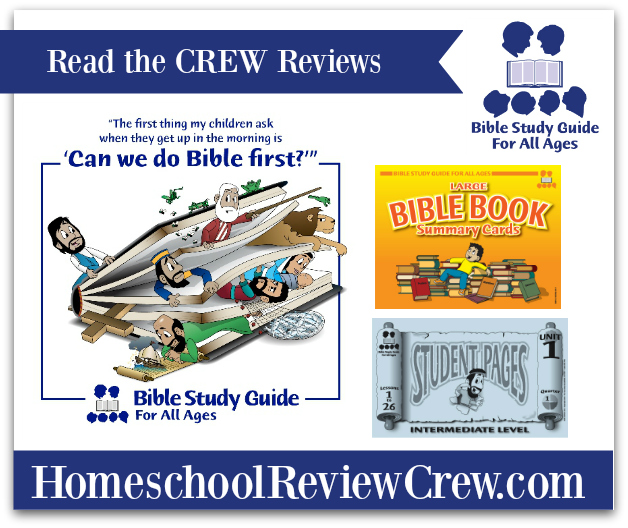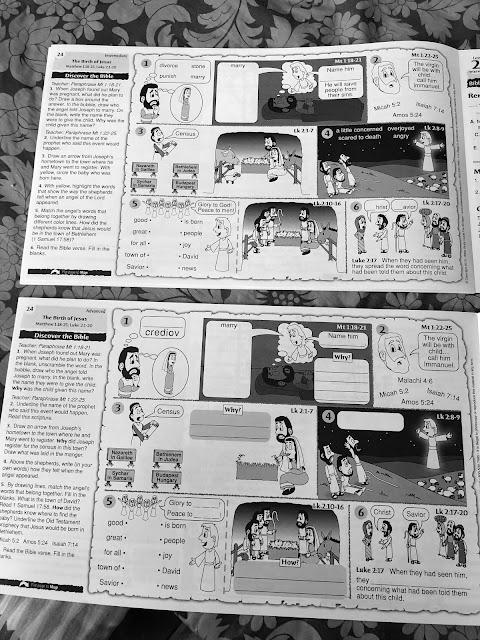Bible Study Guide for All Ages also has programs for students as young as PK3, the elementary levels, and then teens and adults as well. The program is laid out so that traditional homeschoolers can work on this a little bit each day over the course of a week, but it is short enough that the program used in a co-op, cottage school, or Sunday school setting that only meets for a short time each week. (Note: the workbooks are designed to be consumable products, so if you use them in a group learning setting, each child will need to purchase his own workbook.)
While the Primary level runs independently of the rest of the curriculum, the Beginner, Intermediate, and Advanced levels run in the same sequence, only at different levels. (Ok, I know that seems like a sentence filled with redundancies, but bear with me.)
The first few lessons center on Joseph of the Old Testament. Lesson 1 in both levels teaches the story of Jacob and the tribes of Israel, focusing on Joseph's Coat of Many Colors (Genesis 35:23-26; 37:1-11), Lesson 2 segues into Joseph's Dreams (Gn 37:12-36), and Lessons 3 through 14 take learners through Joseph's experiences in Egypt and then Jacob's death. We then jump to study the Book of Daniel, and the Babylonian capture, and more dreams - this time, Nebuchadnezzar's dreams and the promise of a King. In Lesson 21, we fast-forward to the Gospels of Matthew (Mt 1:1-17) and Luke (Lk 2:23-38) and begin learning about the family of the King of Kings, Jesus.
Notice I didn't say "Jude learned," or "Damien learned." Despite different workbook activities, each week, the lessons focus on the same stories. If you're Mama reading the passages aloud, it makes reading times simple: everyone can sit and listen together. By focusing on the same stories in a two-year cycle, it is presented soon enough that there is some familiarity ("I remember that story!") but enough elapsed time that the older student is ready to delve a little deeper. It also means that in group activities, a family actually becomes a group.
Each of these activities would be difficult to do with just a parent and child. In the first one, two people don't make a very large web of lies. In the second, it becomes an "aha!" moment when we realize "telling the truth" isn't just disobedient to adults, but hurtful to their peers as well.
What learning style is your homeschool? It doesn't matter! We're what most would call "eclectic" homeschoolers; I think the term I'd use is "Crew-led." However, there are bits of many learning styles within the program that make it accessible to many. For example:
Classical Method? Repetition, repetition, repetition. Not only do you revisit the same stories, but each lesson has a review of the what is learned.
Charlotte Mason? Active and applied activities in lessons are focused, and I'm not sure there's a more "living" book than the Word of God!
Unit Study? You're taking a topic and finessing it until there isn't much left to learn.
Group Setting? If you did this is a group learning setting where you only had 60-90 minutes to work together, I would focus on reading the Bible story, the Memory Workout, map or timeline activities, and the Get Active and Apply It! sections. The latter two are probably the most suited to a group setting, and the reflection and prayer at the end of the Apply It! makes a naturally good ending.
The Teacher Key is a suggestion at most levels for homeschools but highly recommended for group teachers. I agree with this; how much you will need it will depend on how independently your student is working. Primary Level is the only one where a teacher's key is required, due to the more visual vs. language-based program.
Private Homeschool with multiple children? There are a few options. There are a total of 416 lessons for each level, so you have a significant amount of ground to cover in the two years, especially if you're keeping to a "traditional" 180-day school schedule.
The first option is to divide the activities across two days. This would allow for 5 lessons every two weeks.
- Day 1: Read the Bible passages as a family, and have each student complete the Guess What... and Map activities. Do one level of Get Active and Apply It! activities as a group.
- Day 2: Complete Remember It and Memory Workout sections together, allow students to complete the "paraphrase the story" cartoon activity on page 2, and then regroup for the alternate level of Get Active and Apply It! activities.
The other option would be to do a lesson a day, and just alternate whose "turn" it was for the two group-like activities. You also may want to double up some days, to keep within that two-school-year range. However, the levels do have some flexibility, so you could start a younger student a little early, or run a little later ending the level, without overwhelming or boring a student.
If you have only one child working on the program, working one-on-one with them to complete activities is an option. Again, I'd recommend the Teacher Key if you have an independent student, especially at the Advanced level. I didn't feel I was missing anything by not having the Intermediate Key; most of the answers were quickly figured out by knowing the story. I was glad to have it with Jude because I don't remember the "chapter-and-verse" locations of things through the Bible, so it saved me having to look up if his answers were correct or not.
What Christian denomination are you part of? Again, it doesn't matter. Because this provides the passages for a story, not the story itself, you are free to use whatever Bible translation you prefer. So many Bible programs are focused on the King James Version of the Bible, and it is frustrating as a Roman Catholic. (To us, the KJV is also missing books, but that's another story!) I like that we are able to use our family Bible to read from.
The Bible Summary Cards are full-sheet, full-color, heavy cardstock cards with pictures on one side and written summaries of the topic on the back. They address most books from Genesis to Revelation -- you will not use them all in a quarter, but rather over the course of the entire program. The pack as a whole works with all levels, so with proper care, they will last through several students. I may consider laminating them since they will have so many hands on them.
I still like this program. (I also can't believe that it's been five years since we used it last!) I think I will be checking out the Teen level as well because it's a program that would simplify Bible study to fit our wide range of ages. Jude and Damien are enjoying the "easy" work, but I like that it's not just "busywork" but encouraging them to think about the lessons of the Bible.
The Crew received materials for students in PK3 through 6th grade. Click the banner below to read their reviews of the Beginner, Primary, Intermediate, and Advanced levels, as well as the Bible Study Guide for All Ages Timeline program.

©2012- 2018 Adventures with Jude. All rights reserved. All text, photographs, artwork, and other content may not be reproduced or transmitted in any form without the written consent of the author. http://adventureswithjude.com









No comments:
Post a Comment